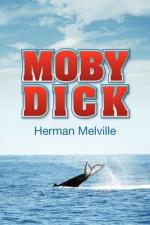That office consists in mincing the horse-pieces of blubber for the pots; an operation which is conducted at a curious wooden horse, planted endwise against the bulwarks, and with a capacious tub beneath it, into which the minced pieces drop, fast as the sheets from a rapt orator’s desk. Arrayed in decent black; occupying a conspicuous pulpit; intent on bible leaves; what a candidate for an archbishopric, what a lad for a Pope were this mincer!*
* Bible leaves! Bible leaves! This is the invariable cry from the mates to the mincer. It enjoins him to be careful, and cut his work into as thin slices as possible, inasmuch as by so doing the business of boiling out the oil is much accelerated, and its quantity considerably increased, besides perhaps improving it in quality.
CHAPTER 96
The Try-Works
Besides her hoisted boats, an American whaler is outwardly distinguished by her try-works. She presents the curious anomaly of the most solid masonry joining with oak and hemp in constituting the completed ship. It is as if from the open field a brick-kiln were transported to her planks.
The try-works are planted between the foremast and mainmast, the most roomy part of the deck. The timbers beneath are of a peculiar strength, fitted to sustain the weight of an almost solid mass of brick and mortar, some ten feet by eight square, and five in height. The foundation does not penetrate the deck, but the masonry is firmly secured to the surface by ponderous knees of iron bracing it on all sides, and screwing it down to the timbers. On the flanks it is cased with wood, and at top completely covered by a large, sloping, battened hatchway. Removing this hatch we expose the great try-pots, two in number, and each of several barrels’ capacity. When not in use, they are kept remarkably clean. Sometimes they are polished with soapstone and sand, till they shine within like silver punchbowls. During the night-watches some cynical old sailors will crawl into them and coil themselves away there for a nap. While employed in polishing them—one man in each pot, side by side— many confidential communications are carried on, over the iron lips. It is a place also for profound mathematical meditation. It was in the left hand try-pot of the Pequod, with the soapstone diligently circling round me, that I was first indirectly struck by the remarkable fact, that in geometry all bodies gliding along the cycloid, my soapstone for example, will descend from any point in precisely the same time.
Removing the fire-board from the front of the try-works, the bare masonry of that side is exposed, penetrated by the two iron mouths of the furnaces, directly underneath the pots. These mouths are fitted with heavy doors of iron. The intense heat of the fire is prevented from communicating itself to the deck, by means of a shallow reservoir extending under the entire inclosed surface of the works. By a tunnel inserted at the rear, this reservoir is kept replenished with water as fast as it evaporates. There are no external chimneys; they open direct from the rear wall. And here let us go back for a moment.




